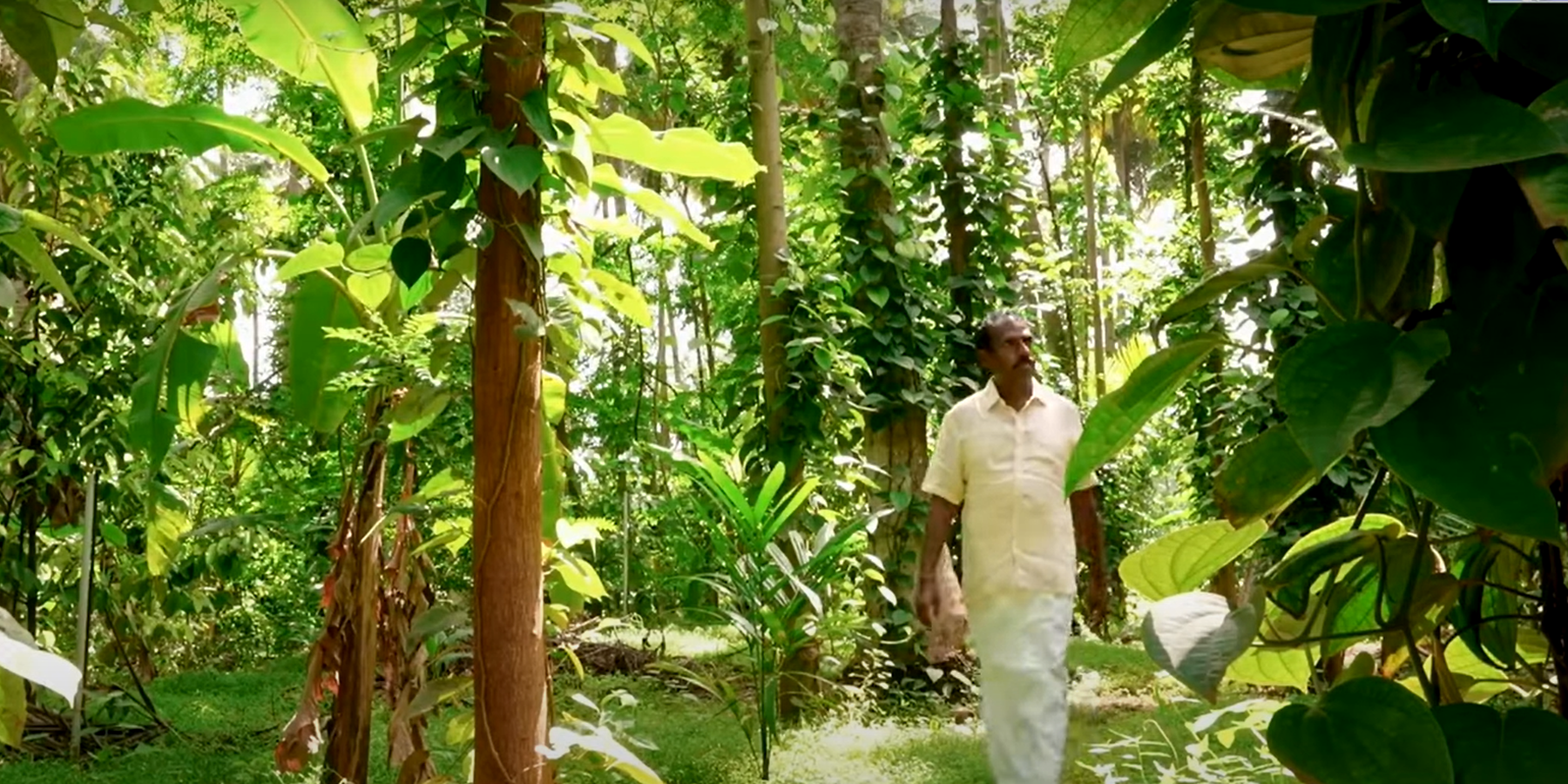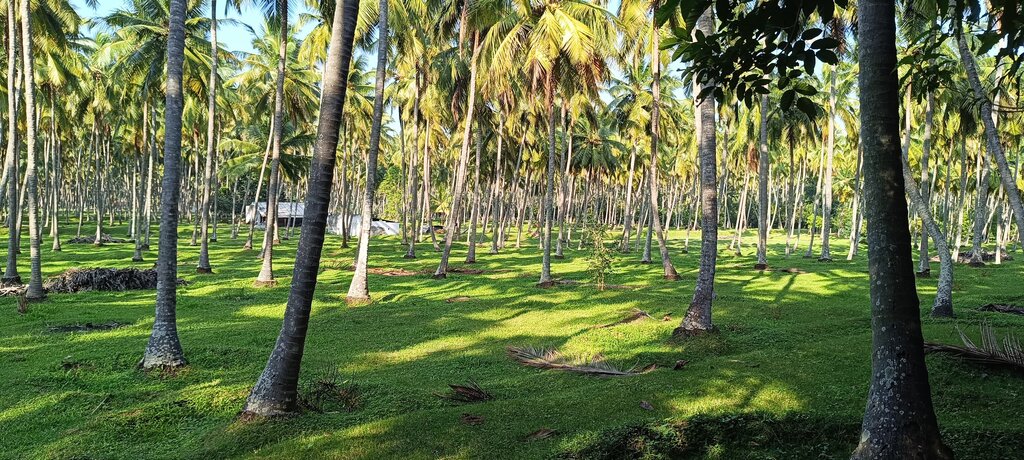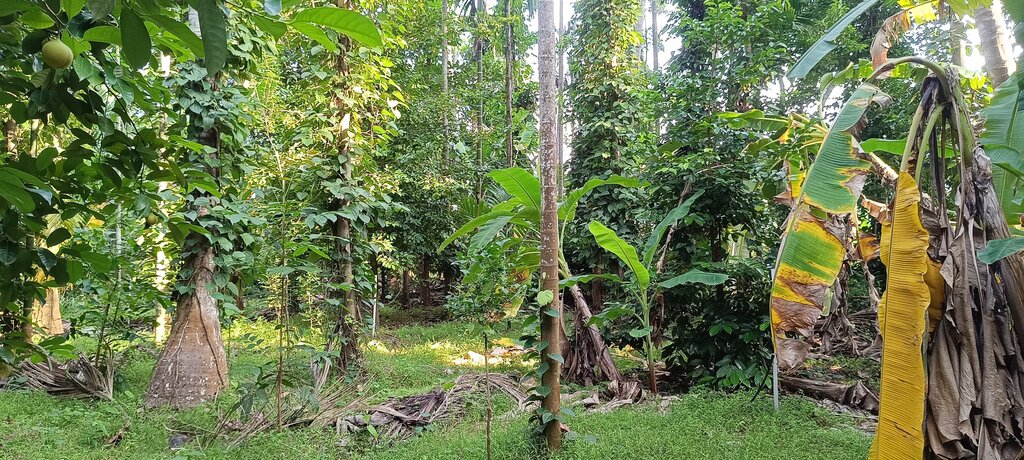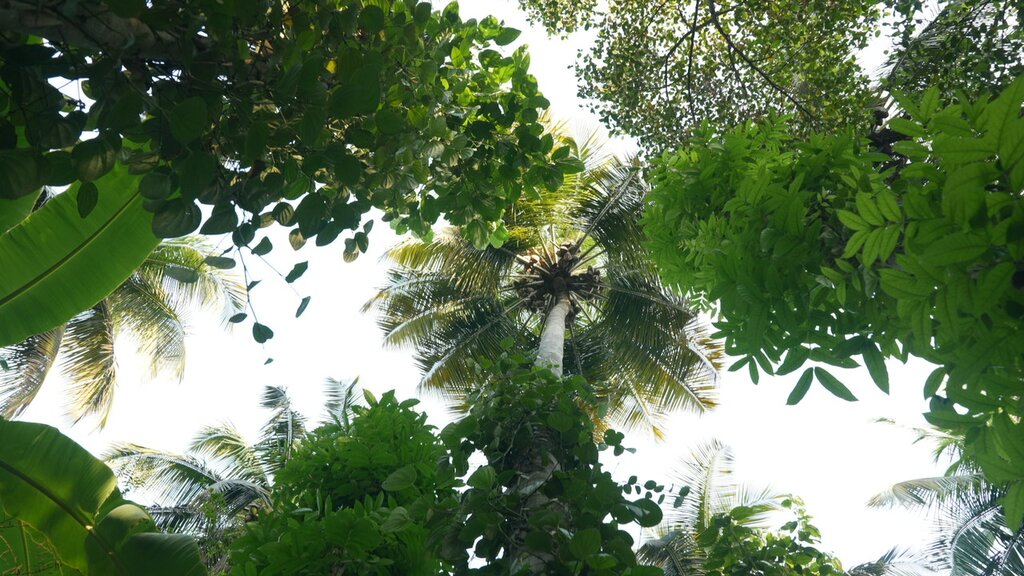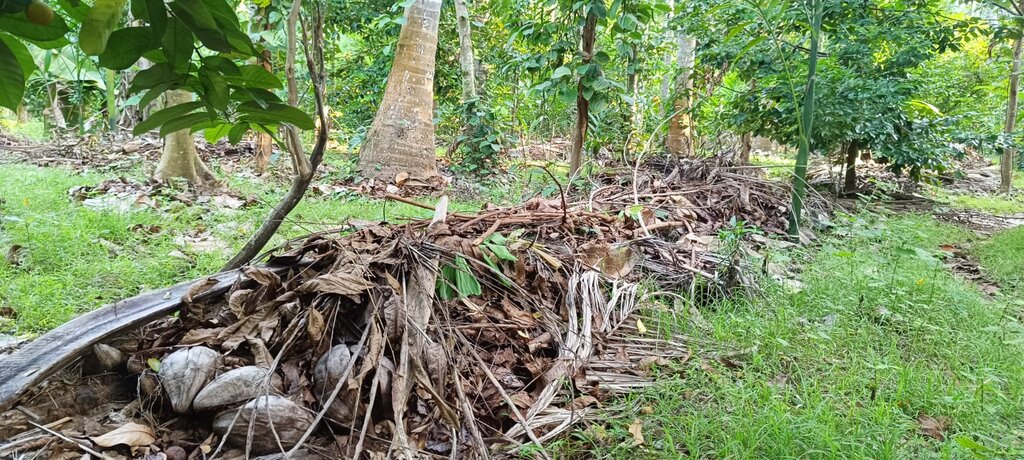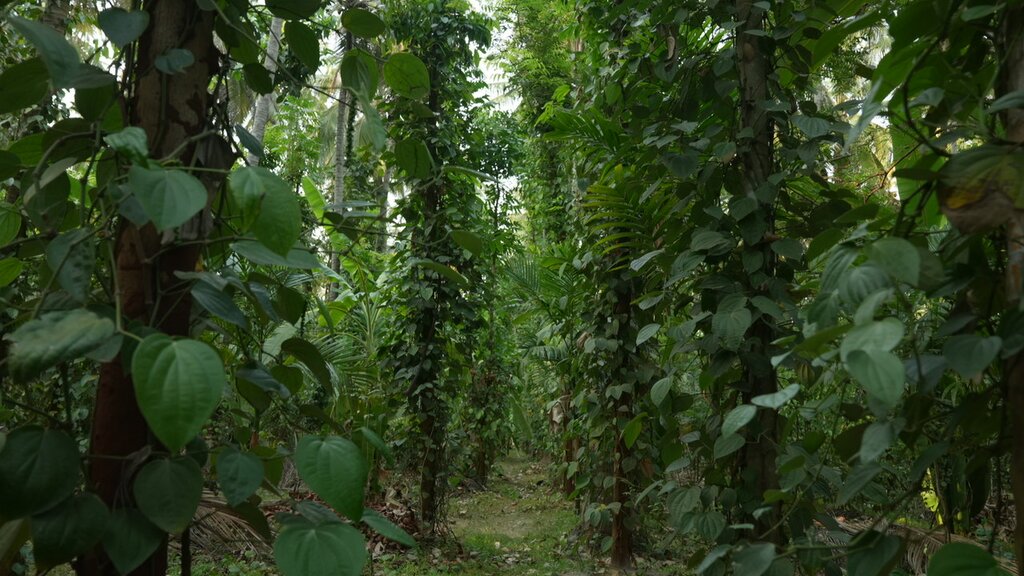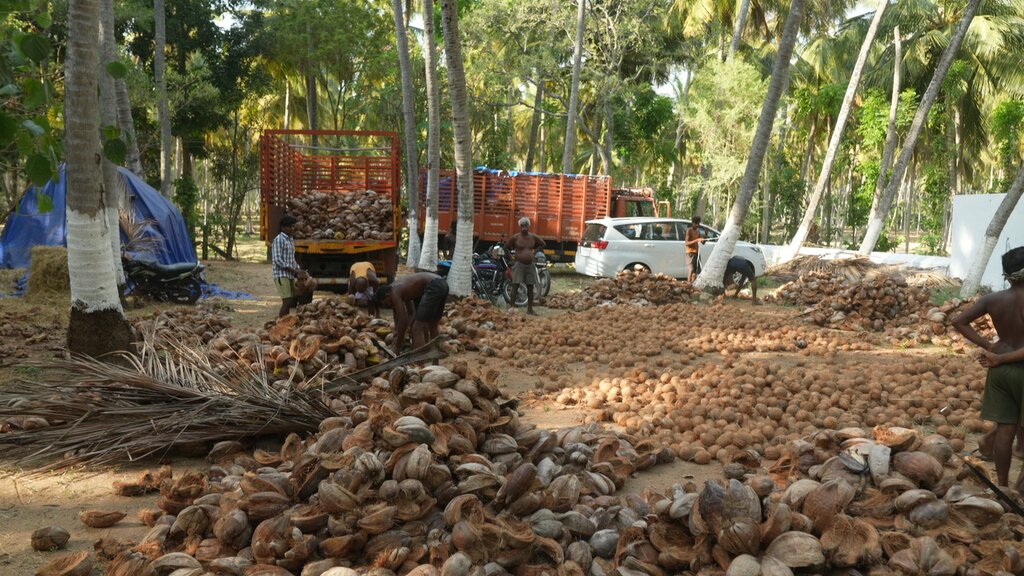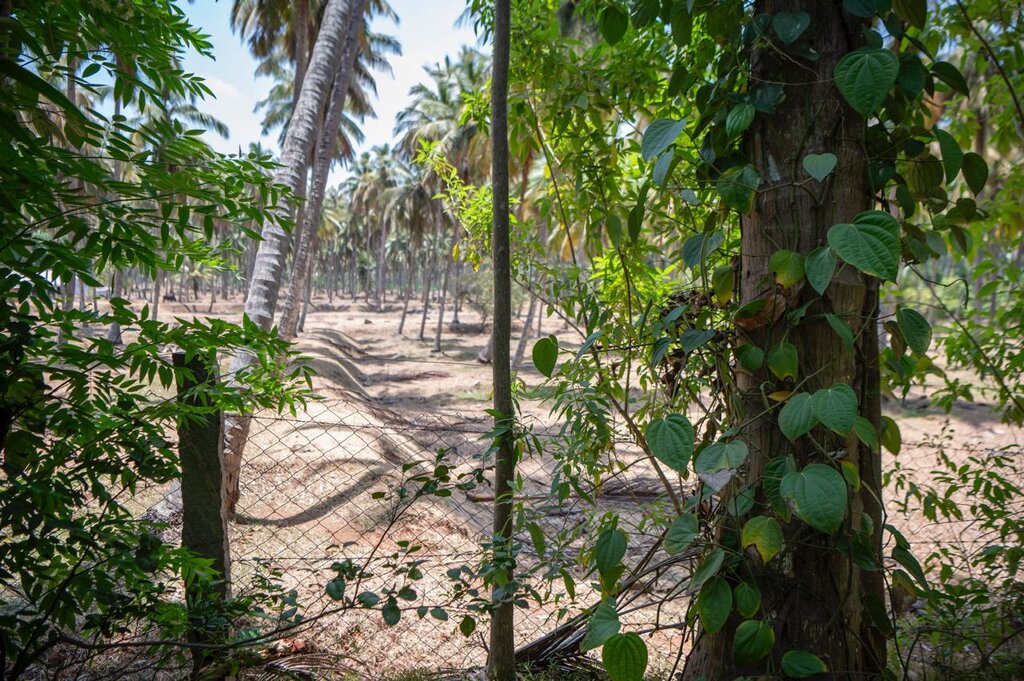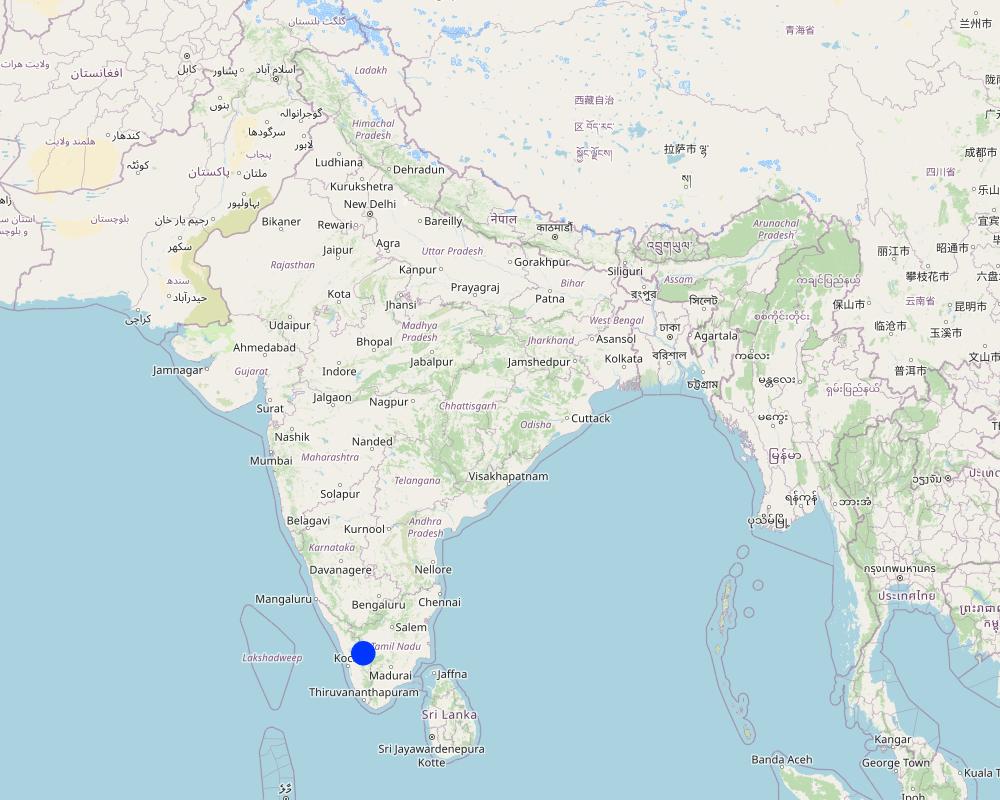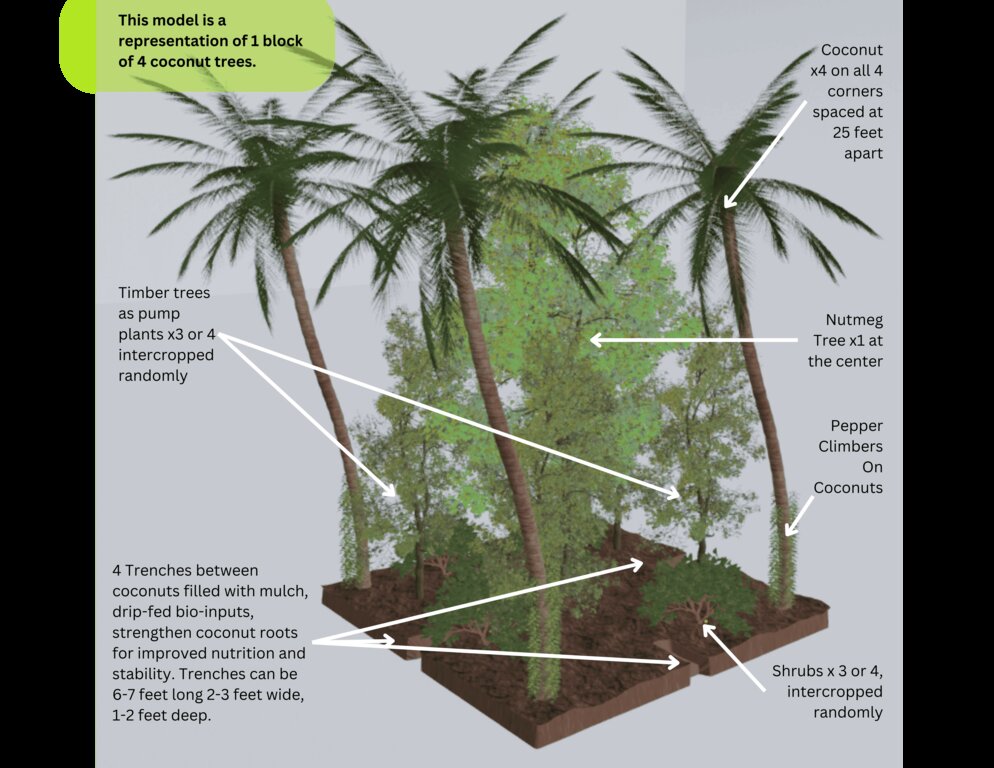Transforming a coconut monocrop into a multi-storey food forest [印度]
- 创建:
- 更新:
- 编制者: Praveena Sridhar
- 编辑者: Rushabh Desadla, Aditya Tated, Dhyana Balasubramanian, Vishwesh Singh, Lu Yu
- 审查者: William Critchley, Joana Eichenberger
Ottraipayir Thennai Sagubadi Muraiyai Pala Adukku Unavu Kaadaga Matruthal.
technologies_7366 - 印度
查看章节
全部展开 全部收起1. 一般信息
1.2 参与该技术评估和文件编制的资源人员和机构的联系方式
SLM专业人员:
SLM专业人员:
有助于对技术进行记录/评估的项目名称(如相关)
Save Soil Movement有助于对技术进行记录/评估的机构名称(如相关)
Conscious Planet - Save Soil (Save Soil)1.3 关于使用通过WOCAT记录的数据的条件
编制者和关键资源人员接受有关使用通过WOCAT记录数据的条件。:
是
1.4 所述技术的可持续性声明
这里所描述的技术在土地退化方面是否存在问题,导致无法被认为是一种可持续的土地管理技术?:
否
1.5 参考关于SLM方法(使用WOCAT记录的SLM方法)的调查问卷
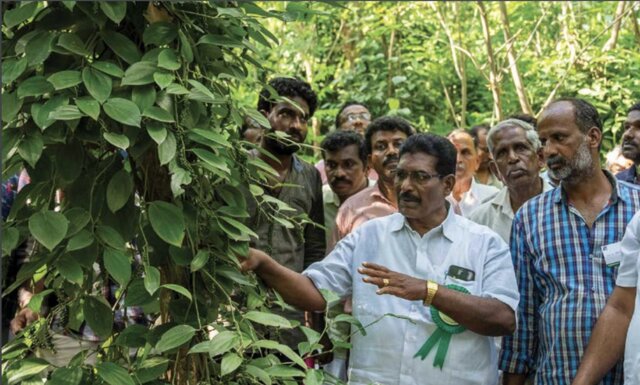
Conscious Planet - Save Soil’s Farmer Training and … [印度]
The approach focuses on supporting farmers to increase productivity by increasing soil biology and organic matter content, primarily through plant residue and animal waste. Awareness and advocacy are followed by training programs and support for adopting regenerative agricultural practices.
- 编制者: Praveena Sridhar
2. SLM技术的说明
2.1 技术简介
技术定义:
Transforming a monocrop coconut farm into a resilient food forest can sustainably enhance soil health, biodiversity and productivity while reducing labour and external input requirements. This demonstrates the potential to increase yields and provide long-term economic and ecological stability for farmers.
2.2 技术的详细说明
说明:
Transforming a monocrop coconut farm into a resilient food forest can sustainably enhance soil health, biodiversity, and productivity while reducing labour and external input requirements. This demonstrates the potential to increase yields and provide long-term economic and ecological stability for farmers. Experience was gained from implementation in 2008 on a monocrop coconut farm in Pollachi, Tamil Nadu. The stages were as follows:
1) Rainwater management: Trenches were dug throughout the farm to retain rainwater and prevent runoff, thus enhancing soil moisture. This was critical given the limited rainfall in the region. A drip irrigation system was installed for efficient watering.
2) Plant diversity: Various crops were introduced. Nutmeg, intercropped among coconut trees, provides 3 - 4 times the income of coconuts after 15 to 20 years. Timber trees extract micronutrients from deeper soil layers via deep tap roots: micronutrients are concentrated in the leaves which are used as mulch to enrich the soil nutrient profile. Banana and papaya provided early income, shade for plants, and added biomass. This diversity also ensures a steady income, reducing dependency on external markets.
3) Biomass and soil fertility improvement: Fast-growing crops were planted to generate additional biomass. Leaves were pruned and added to the water-retaining trenches as mulch. Nitrogen-fixing plants were cultivated extensively to improve soil fertility, eliminating the need for chemical fertilizers.
4) Mulch and bio-input application: Mulch in the trenches was decomposed by the bio-inputs from Cows (Earlier 2, now 1) applied via drip lines, which increased soil organic matter through enhanced microbial decomposition. The irrigation and sprinklers were used judiciously to achieve soil moisture rather than over-watering, as trees primarily needed stable moisture conditions.
5) Minimal maintenance approach: After establishing this system, the farm required minimal maintenance. There was no need for tilling, weeding, or other intensive practices, just monitoring of, and maintaining, moisture levels. This low-maintenance approach reduces farmers’ workloads and improves their quality of life.
6) Enhanced biodiversity and pest management: To further enhance biodiversity, flowering plants to attract pollinators and predatory insects can be planted along the farm's boundaries - though this was not done at this particular site. Nonetheless, the increased biodiversity already fostered here brought in earthworms, birds, and beneficial insects for natural pest management.
After 12 years of minimal maintenance, soil organic matter content increased from 0.5% to 3.36%, and both production quantity and quality increased. The farm retained high soil moisture despite periods of low rainfall. Land users liked the use of minimal inputs, crop diversification as a financial safety net, and the visible impact on soil health and yield, as well as the increase in land value. There was initial fear about time and money invested and doubts about the feasibility of a technology that challenged the status quo of the region. Digging trenches and planting saplings were physically demanding. The initial pest pressure was also a concern before a stable ecosystem was established. The transformation of this coconut monoculture into a diverse food forest has demonstrated a sustainable model of enhanced resilience, productivity, and biodiversity. This model can be replicated across similar regions to help minimize labor and improve farmers’ livelihoods while restoring land and ecosystems.
2.3 技术照片
2.4 技术视频
注释、简短说明:
With a few simple interventions, soil that was infertile was brought back to life.
YouTube video link: https://youtu.be/Pt4AEXzgTfc?feature=shared
日期:
10/06/2022
位置:
Pollachi, Tamil Nadu
摄影师的名字:
Save Soil Media team
2.5 已应用该技术的、本评估所涵盖的国家/地区/地点
国家:
印度
区域/州/省:
Tamil Nadu
有关地点的进一步说明:
Pollachi
具体说明该技术的分布:
- 适用于特定场所/集中在较小区域
技术现场是否位于永久保护区?:
否
Map
×2.6 实施日期
如果不知道确切的年份,请说明大概的日期:
- 10-50年前
2.7 技术介绍
详细说明该技术是如何引入的:
- 通过项目/外部干预
注释(项目类型等):
The key contributions to the project's technical knowledge include Ethirajalu R (Technical Expert), Anand Ethirajal (Operations Lead), and Dr. Poonyamurti (Ethnoveterinary Medicines Expert). Their expertise, along with the valuable insights shared by Indian stalwarts like Nammalwar, Sripad Davolkar, and Subhash Palekar
3. SLM技术的分类
3.1 该技术的主要目的
- 改良生产
- 减少、预防、恢复土地退化
- 保持/提高生物多样性
- 减缓气候变化及其影响
- 创造有益的经济影响
3.2 应用该技术的当前土地利用类型
同一土地单元内混合使用的土地::
是
具体说明混合土地使用(作物/放牧/树木):
- 农林业

农田
- 多年一作(非木材)
- 乔木与灌木的种植
- Climbers : Pepper
多年生(非木质)作物 - 指定作物:
- 香蕉/芭蕉/蕉麻
- 药用、芳香、杀虫植物 - 多年生植物
- Curry Leaves, Lime, Turmeric, Papaya
乔木和灌木种植 - 指定作物:
- 椰子(水果、椰壳、树叶等)
- Nutmeg, Mahogany, Mountain Neem, Kino, Red Sandalwood, Blackwood, White Teak, Iron Wood
每年的生长季节数:
- 1
采用间作制度了吗?:
是
采用轮作制度了吗?:
否
3.3 由于技术的实施,土地使用是否发生了变化?
由于技术的实施,土地使用是否发生了变化?:
- 是(请在技术实施前填写以下有关土地利用的问题)
同一土地单元内混合使用的土地::
否

农田
- 乔木与灌木的种植
乔木和灌木种植 - 指定作物:
- 椰子(水果、椰壳、树叶等)
采用间作制度了吗?:
否
采用轮作制度了吗?:
否
3.4 供水
该技术所应用土地的供水:
- 混合雨水灌溉
3.5 该技术所属的SLM组
- 农业林学
- 改良的地面/植被覆盖
- 土壤肥力综合管理
3.6 包含该技术的可持续土地管理措施

农艺措施
- A1:植被和土壤覆盖层
- A2:有机质/土壤肥力
- A6:残株管理
A6:对残株管理作出具体说明:
A 6.4:保留

植物措施
- V1:乔木和灌木覆盖层

结构措施
- S2:堤、岸
- S4:平沟、坑
- S6:墙、障碍物、栅栏、围墙
- S7:集水/供水/灌溉设备
- S8:卫生/废水结构物
- S9:动植物庇护所
3.7 该技术强调的主要土地退化类型

土壤水蚀
- Wt:表土流失/地表侵蚀

土壤风蚀
- Et:表土流失

化学性土壤退化
- Cn:肥力下降和有机质含量下降(非侵蚀所致)
- Ca:酸化
- Cp:土壤污染
- Cs:盐化/碱化

物理性土壤退化
- Pc:压实

生物性退化
- Bc:植被覆盖的减少
- Bh:栖息地丧失
- Bq:数量/生物量减少
- Bs:质量和物种组成/多样性的下降
- Bl:土壤寿命损失
- Bp:害虫/疾病增加,捕食者减少

水质恶化
- Ha:干旱化
- Hs:地表水良变化
- Hg:地下水/含水层水位的变化
- Hq:地下水水质下降
3.8 防止、减少或恢复土地退化
具体数量名该技术与土地退化有关的目标:
- 修复/恢复严重退化的土地
4. 技术规范、实施活动、投入和成本
4.1 该技术的技术图纸
技术规范(与技术图纸相关):
Area: 25 x 25 square feet.
Number of Coconut Trees: 4
Number of Nutmeg Trees: 1
Number of Pepper Climbers: 4
Number of Shrubs: 3-4 (Lime, Curry leaves, Medicinal herbs and Turmeric)
Number of Timber Trees : 3-4 (Mahogany, Mountain Neem, Kino, Red Sandalwood, Blackwood, White Teak and Ironwood)
Number of trenches : 4 ( 6x3x2 ft each, half in this block, half extended to the next block.
Irrigation System: Drip and a Center Fog Sprinkler for creating moisture in the atmosphere.
Input application: Cow dung and Cow urine mix flows to the trench covered with biomass. Decomposes it over time and creates humus for all the plants.
Initially biomass crops are planted, slowly transitioning to trees as the soil improves.
No maintenance after 3-4 years.
Coconut collected after it drops naturally.
Nutmeg and Pepper harvest happens in 3-4 years, gradually increasing yields.
Shrubs are harvested occasionally for self consumption and direct on farm sales.
作者:
Aditya Tated
日期:
29/10/2024
4.2 有关投入和成本计算的一般信息
具体说明成本和投入是如何计算的:
- 每个技术区域
注明尺寸和面积单位:
5.66 hectares
如果使用本地面积单位,注明转换系数为1公顷(例如1公顷=2.47英亩):1公顷=:
1hectare = 2.47 acres
其它/国家货币(具体说明):
INR
如相关,注明美元与当地货币的汇率(例如1美元=79.9巴西雷亚尔):1美元=:
84.07
注明雇用劳工的每日平均工资成本:
600 INR
4.3 技术建立活动
| 活动 | 时间(季度) | |
|---|---|---|
| 1. | Plot assessment and planning | Before onset of rains |
| 2. | Digging trenches for rainwater harvesting | Before the rainy season |
| 3. | Setting up drip irrigation system | Before planting; dry season |
| 4. | Planting initial tree species (timber, fruit, nitrogen-fixing) | Early rainy season |
| 5. | Planting startup crops (e.g., banana, papaya) | Early rainy season |
| 6. | Mulching trenches with plant biomass | After trench creation, ongoing |
| 7. | Adding bio-inputs to mulch beds | Throughout growing seasons |
| 8. | Pruning trees and returning biomass | Regular intervals during dry seasons |
| 9. | Planting additional companion species | After initial species establishment |
| 10. | Setting up pest repellent measures | As needed, ongoing |
4.4 技术建立所需要的费用和投入
| 对投入进行具体说明 | 单位 | 数量 | 单位成本 | 每项投入的总成本 | 土地使用者承担的成本% | |
|---|---|---|---|---|---|---|
| 劳动力 | Trench Digging | machine-hours | 100.0 | 1000.0 | 100000.0 | 100.0 |
| 劳动力 | Tree Planting | person-days | 75.0 | 600.0 | 45000.0 | 100.0 |
| 设备 | Farm Tools | lump sum | 1.0 | 20000.0 | 20000.0 | 100.0 |
| 设备 | Irrigation Setup | lump sum | 1.0 | 100000.0 | 100000.0 | 100.0 |
| 设备 | Pruning Machine | units | 1.0 | 25000.0 | 25000.0 | 100.0 |
| 植物材料 | Timber Saplings | units | 5500.0 | 3.0 | 16500.0 | 100.0 |
| 植物材料 | Nutmeg Saplings | units | 1000.0 | 20.0 | 20000.0 | 100.0 |
| 植物材料 | Pepper Saplings | units | 1000.0 | 40.0 | 40000.0 | 100.0 |
| 植物材料 | Fruit Trees | units | 500.0 | 100.0 | 50000.0 | 100.0 |
| 肥料和杀菌剂 | Organic Manure | load | 10.0 | 1500.0 | 15000.0 | 100.0 |
| 肥料和杀菌剂 | Organic Pest Repellants | lump sum | 1.0 | 20000.0 | 20000.0 | 100.0 |
| 施工材料 | Fencing Irrigation | lump sum | 1.0 | 200000.0 | 200000.0 | 100.0 |
| 施工材料 | Bio-Input Preparation Unit | lump sum | 1.0 | 200000.0 | 200000.0 | 100.0 |
| 施工材料 | Pipes and Valves | lump sum | 1.0 | 530000.0 | 530000.0 | 100.0 |
| 施工材料 | Tool Shed | lump sum | 1.0 | 50000.0 | 50000.0 | 100.0 |
| 施工材料 | Worker Shed | lump sum | 1.0 | 50000.0 | 50000.0 | 100.0 |
| 其它 | Farm Animals | units | 5.0 | 20000.0 | 100000.0 | 100.0 |
| 其它 | Fodder | annual | 1.0 | 25000.0 | 25000.0 | 100.0 |
| 技术建立所需总成本 | 1606500.0 | |||||
| 技术建立总成本,美元 | 19109.08 | |||||
注释:
Land user bore all costs
4.5 维护/经常性活动
| 活动 | 时间/频率 | |
|---|---|---|
| 1. | Pruning | Every 6 months |
| 2. | Irrigation system maintenance | Annually, before dry season |
| 3. | Mulching trenches | Twice a year, before onset of rains |
| 4. | Adding bio-inputs to mulch beds | Happens automatically with irrigation. |
| 5. | Harvesting fruits and biomass | As and when needed Coconut is collected after it falls by itself. |
| 6. | Replanting missing or damaged trees | Annually, before rainy season |
| 7. | Fencing and protection checks | Quarterly |
4.6 维护/经常性活动所需要的费用和投入(每年)
| 对投入进行具体说明 | 单位 | 数量 | 单位成本 | 每项投入的总成本 | 土地使用者承担的成本% | |
|---|---|---|---|---|---|---|
| 劳动力 | Pruning, mulching, replanting | person-days | 100.0 | 600.0 | 60000.0 | 100.0 |
| 劳动力 | Harvesting | person-days | 300.0 | 600.0 | 180000.0 | 100.0 |
| 设备 | Tools for pruning fencing checks | lump sum | 1.0 | 10000.0 | 10000.0 | 100.0 |
| 设备 | Irrigation system maintenance | lump sum | 1.0 | 10000.0 | 10000.0 | 100.0 |
| 设备 | Fencing maintenance | lump sum | 1.0 | 20000.0 | 20000.0 | 100.0 |
| 植物材料 | Replacement seedlings | pieces | 50.0 | 30.0 | 1500.0 | 100.0 |
| 肥料和杀菌剂 | Preparing organic bio-inputs via irrigation system | lump sum | 1.0 | 5000.0 | 5000.0 | 100.0 |
| 施工材料 | Fencing materials for repair | lump sum | 1.0 | 8000.0 | 8000.0 | 100.0 |
| 其它 | Cow Care and Fodder | kg | 5.0 | 5000.0 | 25000.0 | 100.0 |
| 技术维护所需总成本 | 319500.0 | |||||
| 技术维护总成本,美元 | 3800.4 | |||||
注释:
Land users bore all costs
4.7 影响成本的最重要因素
描述影响成本的最决定性因素:
No factors significantly affected costs.
5. 自然和人文环境
5.1 气候
年降雨量
- < 250毫米
- 251-500毫米
- 501-750毫米
- 751-1,000毫米
- 1,001-1,500毫米
- 1,501-2,000毫米
- 2,001-3,000毫米
- 3,001-4,000毫米
- > 4,000毫米
指定年平均降雨量(若已知),单位为mm:
865.00
有关降雨的规范/注释:
Rainfall Distribution and Seasonality: Monsoon Seasons: Rainfall peaks during the southwest monsoon (June to September) and the northeast monsoon (October to November). August, October, and November are the rainiest months, each with an average precipitation between 167 to 214 mm.
Dry Periods: The driest months are January to March, with very low rainfall, averaging between 5 to 35 mm per month.
注明所考虑的参考气象站名称:
Coimbatore Metrological station, India Meteorological Department’s (IMD) network.
农业气候带
- 潮湿的
Generally warm, with an average annual temperature around 26–28°C (79–82°F). The hottest months tend to be March to May, where temperatures can reach up to 36–40°C (97–105°F), while the coolest months are December and January, with average daily temperatures ranging from 25–26°C (77–79°F)
5.2 地形
平均坡度:
- 水平(0-2%)
- 缓降(3-5%)
- 平缓(6-10%)
- 滚坡(11-15%)
- 崎岖(16-30%)
- 陡峭(31-60%)
- 非常陡峭(>60%)
地形:
- 高原/平原
- 山脊
- 山坡
- 山地斜坡
- 麓坡
- 谷底
垂直分布带:
- 0-100 m a.s.l.
- 101-500 m a.s.l.
- 501-1,000 m a.s.l.
- 1,001-1,500 m a.s.l.
- 1,501-2,000 m a.s.l.
- 2,001-2,500 m a.s.l.
- 2,501-3,000 m a.s.l.
- 3,001-4,000 m a.s.l.
- > 4,000 m a.s.l.
说明该技术是否专门应用于:
- 不相关
5.3 土壤
平均土层深度:
- 非常浅(0-20厘米)
- 浅(21-50厘米)
- 中等深度(51-80厘米)
- 深(81-120厘米)
- 非常深(> 120厘米)
土壤质地(表土):
- 细粒/重质(粘土)
土壤质地(地表以下> 20厘米):
- 细粒/重质(粘土)
表土有机质:
- 低(<1%)
如有可能,附上完整的土壤描述或具体说明可用的信息,例如土壤类型、土壤酸碱度、阳离子交换能力、氮、盐度等。:
Soil type - Red sandy soil
5.4 水资源可用性和质量
地下水位表:
5-50米
地表水的可用性:
匮乏/没有
水质(未处理):
良好饮用水
水质请参考::
地下水
水的盐度有问题吗?:
否
该区域正在发生洪水吗?:
否
关于水质和水量的注释和进一步规范:
Pollachi, the place where the farm is located, water quality fluctuates throughout the year, particularly due to agricultural runoff and effluents from nearby industrial activities.
5.5 生物多样性
物种多样性:
- 低
栖息地多样性:
- 低
5.6 应用该技术的土地使用者的特征
定栖或游牧:
- 定栖的
生产系统的市场定位:
- 混合(生计/商业)
非农收入:
- > 收入的50%
相对财富水平:
- 平均水平
个人或集体:
- 个人/家庭
机械化水平:
- 机械化/电动
性别:
- 女人
- 男人
土地使用者的年龄:
- 中年人
5.7 应用该技术的土地使用者使用的平均土地面积
- < 0.5 公顷
- 0.5-1 公顷
- 1-2 公顷
- 2-5公顷
- 5-15公顷
- 15-50公顷
- 50-100公顷
- 100-500公顷
- 500-1,000公顷
- 1,000-10,000公顷
- > 10,000公顷
这被认为是小规模、中规模还是大规模的(参照当地实际情况)?:
- 中等规模的
5.8 土地所有权、土地使用权和水使用权
土地所有权:
- 个人,有命名
土地使用权:
- 个人
用水权:
- 个人
土地使用权是否基于传统的法律制度?:
是
具体说明:
Private Ownership
5.9 进入服务和基础设施的通道
健康:
- 贫瘠
- 适度的
- 好
教育:
- 贫瘠
- 适度的
- 好
技术援助:
- 贫瘠
- 适度的
- 好
就业(例如非农):
- 贫瘠
- 适度的
- 好
市场:
- 贫瘠
- 适度的
- 好
能源:
- 贫瘠
- 适度的
- 好
道路和交通:
- 贫瘠
- 适度的
- 好
饮用水和卫生设施:
- 贫瘠
- 适度的
- 好
金融服务:
- 贫瘠
- 适度的
- 好
6. 影响和结论性说明
6.1 该技术的现场影响
社会经济效应
生产
作物生产
SLM之前的数量:
110
SLM之后的数量:
160
注释/具体说明:
Coconuts were small in size and fewer in number when the farm was bought. After 6-7 years, the counts increased from 110 per tree per year to 160 and size increased 150% on average.
作物质量
SLM之前的数量:
Not so tasty
SLM之后的数量:
Taste is the best compared to surrounding many farms.
生产故障风险
SLM之前的数量:
50-60%
SLM之后的数量:
0%
注释/具体说明:
The risk of production failure has come down to 0% as there is no pest and disease attack. The coconuts yield continuously throughout the year.
产品多样性
SLM之前的数量:
1
SLM之后的数量:
3
注释/具体说明:
From just one crop to 2 main crops, pepper as a sub-main crop and a variety of fruits for self consumption.
生产区域
SLM之前的数量:
40%
SLM之后的数量:
60%
注释/具体说明:
Coconuts occupied approximately 40% area in terms of canopy. Now in addition to that there is nutmeg which occupies another 20%. Rest of the area is for timber and other supporting crops not included here.
土地管理
SLM之前的数量:
24/7
SLM之后的数量:
1 Day a Week
注释/具体说明:
Farmer before this owner spent hours in weeding, application of inputs and pesticide, burning of crop residue, harvesting coconuts. Now the whole farm needs 2 labour to collect fallen coconuts and turn on the irrigation switches and valves. The farmer comes to visit the farm once a week for monitoring.
水资源可用性和质量
饮用水的质量
灌溉用水的可用性
注释/具体说明:
Earlier the bore wells would run only for a couple of hours and then the water would dry out. Now it fulfills the irrigation requirement without interruption.
灌溉用水需求
注释/具体说明:
Demand for water has drastically come down as the SOC content in the soil has risen.
收入和成本
农业投入费用
注释/具体说明:
There is no expense in any agricultural input apart from maintenance of 2-3 cows. The entire system is automatic. The slurry from the cowshed goes into the tank which supplies input through a venturi to the drip irrigaton system.
农业收入
注释/具体说明:
Farm income has gone up significantly owing to the high yields, multiple crops, better prices, low cultivation and management costs.
收入来源的多样性
注释/具体说明:
Incomes are coming from sale of coconuts, nutmeg and pepper. Coconut oil is also extracted now by the farmer and sold at a high premium price.
工作量
注释/具体说明:
The drudgery of mainting a monocrop and all the works associalted with conventional agriculture is eliminated by 95%. The only workload is to pick up the fallen coconuts and harvest nutmeg and pepper.
社会文化影响
健康状况
注释/具体说明:
The health of the owner and the consumers is greatly benefitted owing to the absense of harmful chemicals and pesticides in the produce.
SLM/土地退化知识
注释/具体说明:
This model is a great source of wisdom about tree-based regenerative agriculture which can counter land degradation. It has all the necessary components of how to convert dirt into soil.
生态影响
水循环/径流
水质
水的回收/收集
地表径流
多余水的排放
地下水位/含水层
蒸发
土壤
土壤水分
注释/具体说明:
Soil moisture is maintained as high levels except for summers when its a little low due to the intense heat this region faces.
土壤覆盖层
土壤压实
注释/具体说明:
Soil compaction has reduced because of the heavy penetraton of tree roots, improved SOC and biological activity in the soil.
养分循环/补给
注释/具体说明:
It is evident from the yields that there is a very resilient process of nutrient cycling happening in the farm compared to what was happening earlier.
土壤有机物/地下C
SLM之前的数量:
0.5
SLM之后的数量:
3.36
注释/具体说明:
The SOC level have increased continously and is still increasing because of the leaf litter that is added continuously throughout the year.
生物多样性:植被、动物
植被覆盖
SLM之前的数量:
40%
SLM之后的数量:
90%
注释/具体说明:
Vegetation cover in the form of trees, shrubs, perennial crops and pepper has shown dramatic increase.
生物量/地上C
注释/具体说明:
Addition of 3 times the number of trees has increased the above ground biomass multiple times.
植物多样性
注释/具体说明:
The farm is now a home for more than 100 species of plants compared to just one when it was bought.
外来入侵物种
注释/具体说明:
There is an absolute balance in the farm ecosystem with no species going out of control. There are no significant weeds as the soil ecosystem and shade doesn't support the common invasive species found in the region.
动物多样性
注释/具体说明:
Minor farm animals are seen. Since its not a large area, enough diversity has not been established.
有益物种
注释/具体说明:
There are no harmful species for which the farmer needs to worry about. All species are beneficaial in some way or the other.
栖息地多样性
注释/具体说明:
Multi layer multi crop system allows various different habitat for a variety of species. Here from high coconut to rich soil undergrond has a habitat diversity of semi-forest which was not present earlier.
害虫/疾病控制
注释/具体说明:
The farmer says he doesn't know what are pests now which was not the case earlier. Earlier his coconuts would be continously be harmed by something or the other.
减少气候和灾害风险
干旱影响
注释/具体说明:
The impact of drought is not significant in this farm because of the green cover, soil moisture, high water tables, year-round water availability and overall resiliance of the system. All other conventional farms face enormous hardship during droughts.
飓风、暴雨的影响
注释/具体说明:
Impact of rain storms is also less as there is enough wind barriers because of the dense vegetation. The coconots have penetrated their roots towards the trenches and underground in search of nutrients making them strongly grounded and able to withstand storms easily.
碳和温室气体的排放
注释/具体说明:
This system is carbon negative as there is no use of chemicals or fossil fuels needed to run any operation except the transportation of coconuts to the markets.
风速
注释/具体说明:
Wind velocity is hindered now due to the dense vegetation.
微气候
注释/具体说明:
The micro-climate is the most tangible change that anyone visiting the farm is able to relish. The coolness inside the farm is completely mood-changing for someone who is entering from outside. It leaves people wanting to live here or create such a place for themselves. Its an oasis in a desert.
对现场影响的评估(测量)进行具体说明:
Soil Fertility: Initially, the soil was likely low in organic matter due to monoculture practices. Through the addition of nitrogen-fixing plants and mulching with biomass, the soil's nutrient levels improved naturally, eliminating the need for chemical fertilizers.
Soil Organic Carbon: Soil organic carbon increased notably from 0.5% to 3.36% due to continuous mulching, the addition of bio-inputs, and water-retaining trenches. These practices enriched the soil with organic matter, improving its structure and capacity to hold moisture.
Erosion Control and Water Retention: Trenches and rainwater harvesting reduced runoff, preventing soil erosion and enhancing water retention, which helped maintain stable soil moisture levels, even in dry periods.
Microbial Health: The use of bio-inputs via drip irrigation boosted microbial activity in the soil, accelerating the decomposition of organic matter into humus, which further improved soil fertility and structure.
6.2 该技术的场外影响已经显现
水资源可用性
注释/具体说明:
It is assumed that as the groundwater table in the site has increased, it would definitely have some effect of the neighboring sites.
对场外影响(测量)的评估进行具体说明:
We have not conducted measurement of off-site ecological impacts for this farm as of now.
6.3 技术对渐变气候以及与气候相关的极端情况/灾害的暴露和敏感性(土地使用者认为的极端情况/灾害)
渐变气候
渐变气候
| 季节 | 增加或减少 | 该技术是如何应对的? | |
|---|---|---|---|
| 年温度 | 增加 | 非常好 | |
| 季节性温度 | 旱季 | 增加 | 好 |
| 年降雨量 | 非常好 | ||
| 季雨量 | 湿季/雨季 | 增加 | 非常好 |
气候有关的极端情况(灾害)
气象灾害
| 该技术是如何应对的? | |
|---|---|
| 局地暴雨 | 非常好 |
气候灾害
| 该技术是如何应对的? | |
|---|---|
| 热浪 | 好 |
| 干旱 | 好 |
生物灾害
| 该技术是如何应对的? | |
|---|---|
| 昆虫/蠕虫侵扰 | 非常好 |
6.4 成本效益分析
技术收益与技术建立成本相比如何(从土地使用者的角度看)?
短期回报:
轻度消极
长期回报:
非常积极
技术收益与技术维护成本/经常性成本相比如何(从土地使用者的角度看)?
短期回报:
中性/平衡
长期回报:
非常积极
6.5 技术采用
- 1-10%
在所有采用这项技术的人当中,有多少人是自发的,即未获得任何物质奖励/付款?:
- 0-10%
6.6 适应
最近是否对该技术进行了修改以适应不断变化的条件?:
否
6.7 该技术的优点/长处/机会
| 土地使用者眼中的长处/优势/机会 |
|---|
| 1) Efficient Rainwater Harvesting: Trenches prevent water runoff and retain moisture, helping farmers adapt to water-scarce conditions. Drip irrigation ensures efficient water use, reducing waste and improving moisture availability at plant roots. |
| 2) Nitrogen-fixing plants and bio-inputs build natural soil fertility, reducing or eliminating the need for chemical fertilizers. |
| 3) Income Stability: Diverse crops (timber, fruit, and cash crops like bananas and papayas) ensure year-round income and minimize dependency on a single crop. |
| 4) Pest and Disease Management: The natural ecosystem with pollinators and predatory insects reduces pest issues without needing chemical pesticides. |
| 5) Minimal Labor: Once established, the system requires less labor with minimal tilling or weeding, allowing farmers to save on labor costs. |
| 6) Increased Yield and Quality: Coconut yield has improved significantly, with larger and better-tasting coconuts, enhancing the crop’s market value. |
| 7) Ecological Balance: The increase in biodiversity supports natural pest control, improved pollination, and enriched soil. |
| 编制者或其他关键资源人员认为的长处/优势/机会 |
|---|
|
1)Positive Environmental Impact: Enhanced Soil and Water Conservation: Rainwater harvesting and mulching contribute to soil health and sustainable water use, supporting resilient agricultural practices. Carbon Sequestration: The introduction of timber and fruit trees aids in carbon capture, helping to mitigate climate change. |
|
2)Increased Biodiversity and Natural Pest Management: Reduction in Chemical Usage: Biodiverse ecosystems reduce reliance on pesticides and chemical fertilizers, fostering healthier food systems. Positive Environmental Metrics: Biodiversity and natural pest control align with ecological sustainability, improving farm ecosystems. |
|
3)Model for Replication and Scaling: Technology Viability: A successful pilot farm serves as a model that other farmers can adopt, promoting tree-based agriculture and natural farming methods. Long-Term Sustainable Farming: This low-maintenance, high-diversity model provides a sustainable alternative to conventional farming, attracting interest from stakeholders focused on sustainable agriculture. |
|
4)Attracting Donor Support: Appeal to Donors: The project’s long-term sustainability and eco-friendly practices attract donors focused on climate resilience and food security. Potential for Diverse Funding: The combined focus on environmental sustainability, economic empowerment, and climate resilience appeals to various funding sources. |
6.8 技术的弱点/缺点/风险及其克服方法
| 土地使用者认为的弱点/缺点/风险 | 如何克服它们? |
|---|---|
| 1) Learning Curve: Farmers may need additional knowledge on tree-based agriculture and organic soil management, which could necessitate training and support. | 1) Training programs across the project region are conducted on various aspects of regenerative agriculture at minimal costs |
| 2) Consistency in Bio-input Application: The effectiveness of bio-inputs depends on regular application; skipping or improper application could hinder soil improvement. | 2) Farmer hand holding is available via farmer helpline for basic queries and farm visits are conducted if nature of query requires. |
| 3) Higher Pest Pressure in Early Stages: As biodiversity builds up gradually, farmers might initially encounter some pest pressure until a stable ecosystem is established. | 3) Pest and disease management trainings are quite frequent and also the training video is available on Save Soil youtube channel in regional languages for easy access for farmers |
| 编制者或其他关键资源人员认为的弱点/缺点/风险 | 如何克服它们? |
|---|---|
| 1) Need for Technical Expertise and Training: Farmers may need intensive training in regenerative agriculture methods, necessitating resources for workshops, materials, and ongoing support staff, which may impact the organization’s budget and staffing. | 1) Major portion of funding goes into trainings and to create online and offline materials easily accessible to farmers. In mega training program where more than 1000s of farmers attend, free technical handbook is also provided to support them on a daily basis |
| 2) Difficulty in Immediate Impact Measurement: Due to the delayed returns, reporting immediate success and impact might be challenging, especially in a results-oriented funding environment. | 2) Need to implement milestone-based metrics, proxy indicators, and comparative reporting to showcase early progress. Farmer testimonials and case studies further illustrate positive outcomes, while data visualizations offer accessible insights into ecological improvements and economic stability. |
| 3) Risk of Low Farmer Adoption: Farmers may be hesitant about the model’s initial costs and labor, slowing adoption. | 3) Selective aspects of the technology can be taken up initially to see early success in order to manage finances |
| 4) Resource-Intensive Monitoring and Data Collection: Tracking soil health, biodiversity, and yields requires dedicated monitoring, which can be resource-intensive, especially across multiple farms. | 4) Success of few model farms will convince farmer community to take up this technology without having the need to monitor each and every farm |
7. 参考和链接
7.1 信息的方法/来源
- 实地考察、实地调查
3-5 expert volunteers visited the farm for this survey.
- 与土地使用者的访谈
1 person talked to the land user.
- 与SLM专业人员/专家的访谈
2 specialists were interviewed.
- 根据报告和其他现有文档进行编译
4 people were involved in documentation and reporting.
(现场)数据是什么时候汇编的?:
25/10/2024
7.2 参考可用出版物
标题、作者、年份、ISBN:
Cauvery Calling: Impact Assessment Report 2024: A global economic model for farmers with a significant ecological impact
可以从哪里获得?成本如何?
https://drive.google.com/drive/u/1/search?q=UNCCD%20policy
标题、作者、年份、ISBN:
SS-TKV Annual Report 2023-24
可以从哪里获得?成本如何?
https://docs.google.com/document/d/1vvMD0kd-qWs4JtebbsBpOGBB-z_6CVr3ZcrK-1wV78Y/edit?tab=t.0
7.3 链接到网络上的相关信息
标题/说明:
Save Soil Movement - Model Farm, Proof of Concept
URL:
https://consciousplanet.org/en/save-soil/blog/save-soil-movement-model-farm-proof-of-concept
标题/说明:
A living example of Save Soil
URL:
https://www.youtube.com/watch?v=QVis4gkcPIU&t=353s
7.4 一般注释
The farm is still undergoing transformation into a more efficient and profitable model with the technology implemented.
链接和模块
全部展开 全部收起链接

Conscious Planet - Save Soil’s Farmer Training and … [印度]
The approach focuses on supporting farmers to increase productivity by increasing soil biology and organic matter content, primarily through plant residue and animal waste. Awareness and advocacy are followed by training programs and support for adopting regenerative agricultural practices.
- 编制者: Praveena Sridhar
模块
无模块


